Resources
★Transcripts:
1.Xizhi Interview Transcripts
2.Water Resources Agency Transcripts
3.Mr. Jui-Wen Chen Interview Transcripts
4.Mr. Shen-Hsien Chen Interview Transcripts
Mr. Jui-Wen Chen Interview Transcripts
Interviewee: Jui-Wen Chen
Interviewers and organizer: all team members
(1)Did you have a bad grade since the beginning? Or did you just hate reciting text? Did you have any classes you like? What were your parents think about your schooling?
I was sincere and honest and have a lot of ideas of my own. But I don’t know how to express myself. When people said something, I could only agree or disagree; I didn’t know how to communicate, could only respond with “Ok” or “Not ok.” On top of that, I was the youngest child, my parents beloved me, and they didn’t ask much from me. I was slowed to respond. Though I wasn't stupid, in others eyes, I just couldn't respond in time.
In fourth grade, I met a strict teacher who had a very high standard for students. Getting punished and receiving beating became a constant occurrence. I faced a lot of pressure, trying to do this and that. Take reciting of the text for example, the teacher required the students to recite the text for every lesson, and I was slow at doing things and reciting the text. Therefore, I got punished so much that it became like a routine. Thinking that I would get punished no matter how hard I had tried to recite the text, I just simply gave up. On top of that, because of my stubbornness and rebellion, I thought I might as well give up everything. So I dropped all the schooling and even burned the school bag, unwilling to go to school at all.
Up until this point, my mother was still nice to me and never blamed me. She would plead and urge me to finish at least the mandatory junior high school. Seeing no other way, I could only pick the book bags up again, went to school, and kept on daydreaming.
(2)Didn’t you even have a favorite class?
Back then, the elementary school teachers taught and controlled everything, so I gave up on everything. When I was in junior high school, the students had to go to different class. Since I was used to giving up, I was doing nothing and daydreaming in junior high school as well. But there were two classes that needed hands-on work, and they were actually more interesting. One was the sculpting class, and maybe because I had pretty skillful hands, I thought I had even made some good sculptures in the class. The other class was the physics class. The teacher, Mr. Hsin-Ping Chen, would let us do experiments in class, and I was interested in these hands-on lessons. On day, he said to me all of a sudden, “I don’t think you are really stupid. Why can’t you apply yourself more?” I couldn’t remember what I said in class on that day that made him said those words so unexpectedly. I thought everybody believed I was stupid, why he would say those words and even give me the keys to the science lab and asked me to keep it safe. Maybe he thought I was stupid and wouldn’t steal things from the lab. However, what he said had a profound impact to me; I thought if this was a call for me to study more.
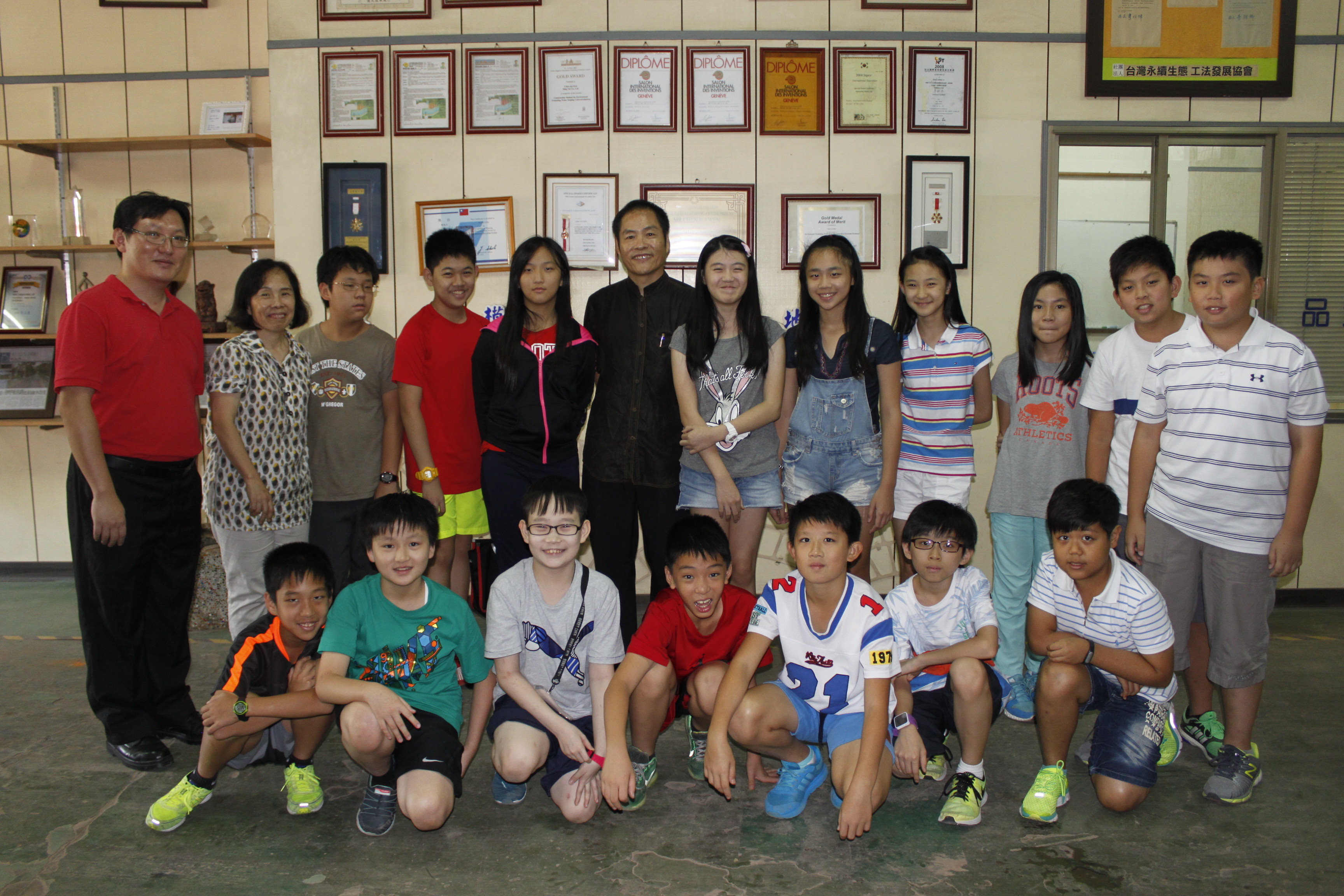

(3)What kind of temple did you help build? Was it a Confucius Temple? Is it the Shin-Lin Temple now?
The temple I helped built was the Wen-Wu Temples next to the Shin-Lin Temple. I help built the Wen Temple. Shin-Lin Temple is 300 meters away from my house. For a country boy, that was my part of my playground, and I played there everyday. When the Shin-Lin Temple was building the Wen-Wu Temple, I would go there and look around from time to time.
I helped laying down the foundation of the Wen-Wu Temples. So every time I go home, I would say to Confucius, “It was me who helped laying down the foundation for the temple. Though I didn’t get knowledge from the schooling, you will need to bless me with wisdom.”
(4)Did you get paid for helping in the temple building?
At first, I only did things there were easy, didn’t think much about the pay. I just thought it was a fun thing to do. I was active all the time and would do whatever the chief master asked me to do. Since I was strong, tireless, not afraid of dirt or anything, and could not stand still, I looked for things to do all the time. I enjoyed it a lot. I felt that temple building was so much different than the school work. In school, the lessons were not flexible; while there were many things to do in the temple building site, like the how to place and cut the stones, all needed to think about the dimensions and the process of making them.
Since the master craftsmen back then never explained why, they would only tell you to do the work like theirs, I didn’t feel pressured but exited. Therefore, when I started laying the stones, I figured things out on my own and made the decisions myself. The way the master craftsmen showed me how things work by letting me figuring out myself really suited my taste, and that’s how I could learn the most.
I didn’t think of the money at first, however, since I was quick to react and work hard, and hurrying to get everything done, I learned fast and worked hard and effectively. It was in the 1970s, the chief master gave me 50 dollars everyday while the other master craftsmen only got paid between 40 to 50 dollars. Maybe that had something to do with me being strong and effective and had pretty good quality of work.
(5)Why did you choose the mason work, rather than the sculpting work when building the temple?
Sculpting is a slow work. At the time, I didn’t want to do something that requires arts. The thought that spending my entire life in a small room making the sculptures was just too small of a challenge for me.
Since I was little, I didn’t want to have a normal and easy life like others. I asked myself frequently that if I don’t want to waste my life, would I want to leave money or fame behind? I don’t want to start my life over. More importantly, it is not the money or fame I want to leave behind, it is a spark of light for the betterment of human race that I want to leave behind. So since I was little, I wouldn’t do things that everyone was doing, doing only those that nobody was willing to do. For example, if I were to win the race, I had to practice running on the outer lanes. Only by running further and faster that I could surpass others.
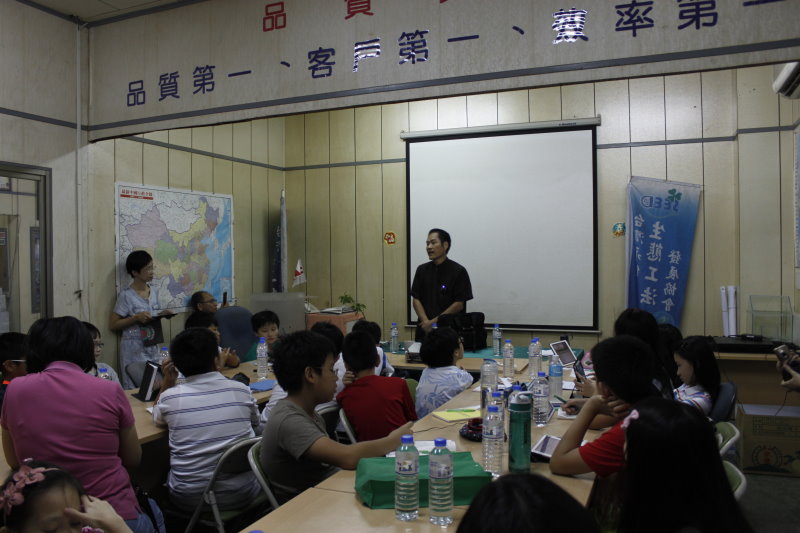

(6)Why would you leave your home and find a job in Taipei?
If I stayed at home, I would only farm. But when I got close to mullet-drying work, I would get allergic reaction. Moreover, though I was interested in temple building, once the temple completed, there wouldn’t be more work for me. Therefore, I decided to leave home and go to find work in Taipei.
(7)Did you find the mason work in the first place?
At first, I worked in a relative’s textile factory. At the time, the textile and knitting factories exported many of their products abroad, which opened up excellent job opportunities for those looking for work. Even though I didn’t have any experience, he hired me immediately. He let me operate a machine, moving the handle left and right, and make sweaters. However, after a week, I felt this work was too dull, repressed, and boring, like sitting in a classroom. Moreover, it wasn’t challenging or had good expandability for myself. Therefore, I told my older brother that I no longer interested in working in a textile factory, and if he could find me another job.
Since he was a mason at the time, he took me to find a master of masonry and learned the trade.
(8)When you were a mason, what were the skills you learned from the master of masonry?
When we were working with the master of the masonry, besides the mason work like laying bricks and building, another part of the job was to cover the walls with tiles. However, we didn’t stay too long with the master. After a while, my brother and his other friends decided to leave and started their own masonry business, and I joined them.
To neatly cover the walls with tiles, you need to set up the guiding lines first. In the beginning, I followed the steps and set up the guiling lines and put up the tiles slowly. Once I got more familiar with the routine, I started using my own way. In less than a year, I became very good at it. I could cover wall with tiles better and faster than others.
At that time, if one could finish the tiles for the kitchen and the stove in two days, he would be considered as a master mason. An even better one, like a master mason named Taca, could finish those in one day. I, on the other hand, could finish TEN of them in just one day. Some of those master masons back then would have to show their respect when they heard my name!


(9)What was the reason that made you wanted to become a boss yourself?
About a year later, my brother was getting married, so he broke off from his friends and became a boss himself. At the time, the construction business was blooming, so there were a lot of mason work. My brother thought I had learned just about all the craft and believed I could try leading a team of workers myself.
Because I had a good reputation working under my brother, people in the business knew I had the skills and and worked fast. Therefore, I became a boss myself and got many works thereafter. I was seventeen and a half that year. I was a boss since seventeen years old.
(10)Masonry is just part of the building construction. How did you come from building houses to building roads?
I had a pretty good business as the mason contractor. Then, I started the construction company, building houses as whole. Building construction needs to include steel reinforcement, cement work, electric work, tile work, and everything else. There, of course, were some public construction works that we also did, and some of them included building the roads.
(11)Why did you publish the research papers in journals with other scholars?
Normally, I would find some scholars to do the research together, for I am the inventor and the promoter of the technology. In a research project, the order of the names appeared on the research paper matters, and I would always let them put their names first and put mine at the end. I published these paper in order to prove that this technology works, and there are evidences supporting that.
(12)Was there an Aqueduct Grate in the award-winning product in the first place?
The award-winning product has the Aqueduct Grate in the beginning. Later on, it is modified based on the different needs. However, the different pipe sizes have existed since the start, and the main structure doesn’t change at all.
(13)Why was the Aqueduct Grate designed in such way?
From the experiments, the results showed that when the spread between the grates is too big, the structural integrity and the breathing effectiveness are not as good. On the other hand, when the spread between the grates is too small, the cost becomes too much. Considering the balance between the cost, the breathing effectiveness, and the structural integrity, the 10 cm by 10 cm grate that you see is the result of that. I choose to use the square-shape grates because it has the structural mechanics can best spread the stress. The diagonal lines in the square can also provide reinforcement to the entire structure, making it stronger.
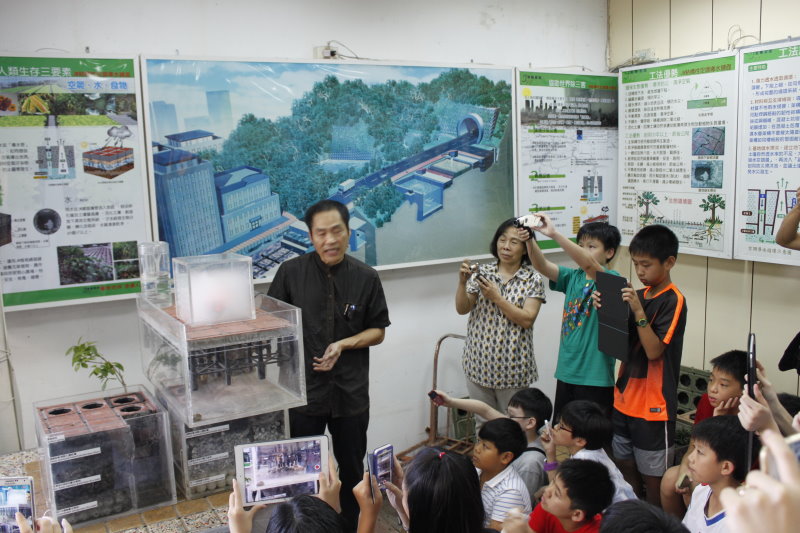
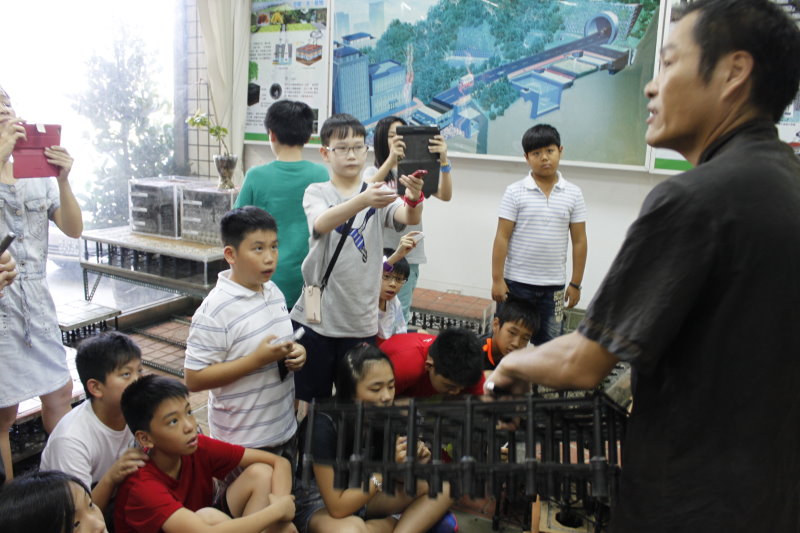
(14)What is the relationship between the JW Imprinted Pavement and the JW Eco-Technology?
The JW Imprinted Pavement is a patent I got about 30 years ago. The Pavement Imprinting Templates are put on top of the still-wet cement and peeled off when the cement is dried. The idea came from printing press. This pavement is not permeable, but it looks beautiful. The breathing road uses the Pavement Imprinting Templates to make the surface more variable and more beautiful.
(15)Why are there narrow and wide pipes?
When first started the invention, you would have to think about the kinetic energy it has. I use plastic because I have tried iron, aluminium, and other materials. You would find that they were expensive and ineffective because iron would rust, other materials cost too much, and the strengths decreased as time goes. Later, I thought about plastics because it won’t break for centuries and last for a long time. Why not using it? I have tried many materials, and the use of plastic was a huge turning point in the development of the technology.
(16)What type of plastic do you use?
It is called PP (Polypropylene). The advantage of using PP is that it won’t release its toxic materials until it’s above 130 degrees Celsius or below -40 degrees Celsius. This is important because with such huge range, it won’t cause negative impacts on the environment. It’s very unlikely to have the temperature of an environment raised above 140 degrees Celsius. On the other hand, when adding deicing agents on the surface of the pavement, it will be able to handle temperature even colder than -40 degrees Celsius.
(17)Won’t the holes of the JW Eco-Technology get blocked?
No, it won’t because the Aqueduct is designed to have a narrow and wide pipes. The narrow pipes will allow water drainage and dirty water to enter into the surface below. Water will infiltrate into the gravel and soil. The dirt will help create a suitable environment for microorganisms, which will help clean the air; the microorganisms will continue to thrive in this environment. Then, using the Bernoulli Principle, the clean air and moisture will be released into the atmosphere above through the wide pipes.
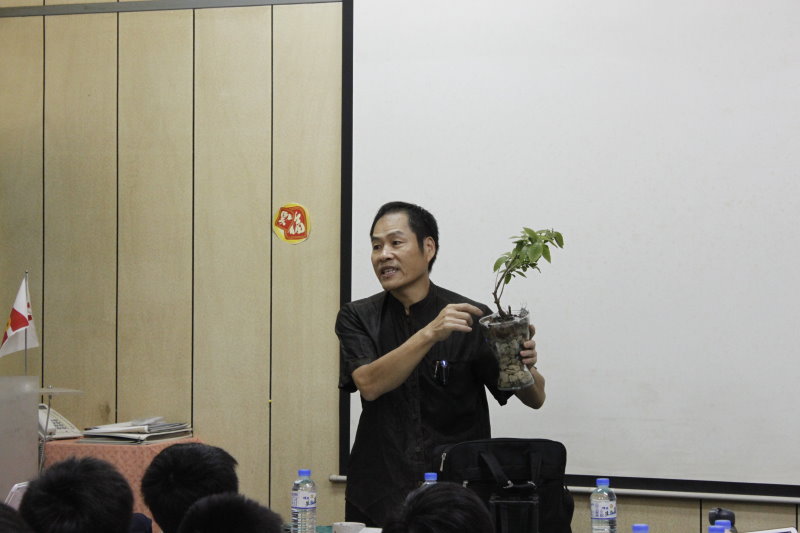

(18)Can you explain the different types of Water Retention Balls and the different purposes?
The Water Retention Balls are designed to have five holes on either side. The main purpose is to increase the water-storing capacity. It can also provide some pockets of air for creatures and microorganisms to breathe even when it’s filled with water. The Water Retention Balls are placed in the gravel layer to store more water and provide some living space for creatures and microorganism.
The colors on the different types of the Water Retention Balls is an idea of mine. They help people distinguish the differences.
The green ones are the eco balls. They contain the ash of burned rice hull and serve to provide nutrient and a suitable environment for microorganisms to thrive.
The red ones are for flood prevention. They are hollow and empty inside and serve to store water.
The blue ones are for long term water retention. They have sponges inside that serve to retain water and maintain air moisture for a long period of time in a dry area.
The black ones are for detoxification. They have charcoal inside, and charcoal can help us removing the heavy metals and other pollutants.
The white ones are for maintaining the local environment. They have the soil of the pavement site, so that the microorganism in the soil will not leave the place and face extermination. Using the white balls, the microorganisms in the soil can remain in the same place and continue to thrive.
When you think about environmental protection, like growing a tree, you have to think of a way to avoid causing harm to the environment when paving the road. Therefore, you will have to help these microorganisms, whose lives you interrupt, to find an environment for them to continue their way of living. The Water Retention Balls not only has the capability to store water, but also allows the ecosystem to thrive.
(19)What makes you think of using a sphere to create these Water Retention Balls the first place?
Because the balls are sphered-shaped, they are stable. The spheres can disperse the force from the outside more evenly, so they can withstand more force and are not easy to break.
(20)When did you start the development of the technology?
I worked as a manual labor, a mason, a masonry contractor, a builder, and eventually a building contractor. After I left the building contractor business, I imported and exported the white tiles. I had an A++ rating—a modeled merchant—because I didn’t smuggle and would always file the taxes honestly. The sales were really good for all the products I imported. One of them was the white drywall tiles. At the time, Hsin Tung Yang Construction Corp. had invested one billion in their tiles, and so had the Chia Hsin Cement Corporation. However, I had the market share up to 80 to 90 percent. Both of them lost their money because they didn’t provide the technology; while I earned mine from the technical support we provided.
Then, onto another stage, I rented a factory from a friend about 20 years ago and opened the Ping Tai World Building Materials Store. It was even bigger than the B&Q. However, I didn’t know that I had opened it in a wrong place. That industrial land was limited to the investment for the high-tech industry and not for other purposes. So, in the end, the factory was closed.
Although I had been doing the research and developing the technology, I wasn’t as focused. Because of the failure on the Ping Tai World Building Material Store, it was at the point that I focus on the research and development of the JW Eco-Technology.


(21)Did you use the JW Eco-Technology for your first exhibition?
Yes, but many people didn’t understand it and couldn’t see its advantages. In the beginning, I didn’t know how to show my invention. I participated in the Presidential Award, Scientific Award, and National Exhibition. The judges didn’t always understand my invention. Those judges without knowing the concept of environmental conservation or without the professional knowledge about the subject were not able to make any connection with my invention. On the other hand, for those who were the experts in the field and were doing the research, they understood the invention very well. They were in shock and wouldn’t dare to let you get the awards and recognitions. Therefore, it was difficult to get the award in the country at first.
However, when going to the exhibitions abroad, it was very easy to get the awards and medals. It wasn’t always the same in Taiwan. In recent years, because of the public opinion and the fact that I got so many awards abroad, the judges here no longer dare to ignore me nor being so careless, so I started getting the awards.
(22)What was your first exhibition abroad like?
It was very popular. The first exhibition I participated was the Geneva International Invention Fair. The foreign companies and scholars were both very interested in my technology. One of the dean or professor from the Royal Swedish Academy of Sciences even returned several times and kept wanting to recommend me for the Nobel Prize. When you exhibit there, people could feel your care and passion for changing the environment for the better, instead of treating you like a merchant. In Taiwan, they only see the invention as a product. What can you do about that?
Ten years ago, I lost the contact to that professor because of a fire. Moreover, there was a translator from China who claimed that he had friends in the government to help introduce and promote the JW Eco-Technology in China.
(23)How many countries have used your technology?
There were too many to count, at least several dozens, and more than 80 to 100 countries are still in the process of negotiating. These countries come from all five continents. Now, there are several representatives in Australia, city mayors, the University of Illinois, the United States National Academy of Sciences, and people from Germany all asked me to present there. Since I don’t have a strong language skills, I need a translator and can’t travel alone. The foreigners as well as those who care a lot about the environment see this. Read the newspaper in the past few days, more and more people care about environmental protection.
(24)How was the foreign royalty calculated?
When I was in the United States, I asked for 20 million US dollars for the royalty and 51% of the equity of the company that holds 20 million capital. I wasn’t really serious when I proposed this demand. I meant it to be somewhat of a hassle, hoping they would give it up on their own. However, the manufacturer in that city was still very interested, seizing the opportunity to conduct the business with us.
I should say it this way. If one cares about environmental issues, one will naturally be interested in our JW Eco-technology.
(25)Have you ever participated in the exhibition of the global climate summit?
No, the exhibition in Paris was our first time to participate in the global climate summit. We were able to participate this time because we think all the research on our technology is well established with the scientific data and the theses available. We can clearly explain to the international community that we are working on “An Environmental Problem—We Offer a Solution.” From scientific research, publication, to theses, we provided them with the data and real applications to support that our technology is able to pass all the tests.
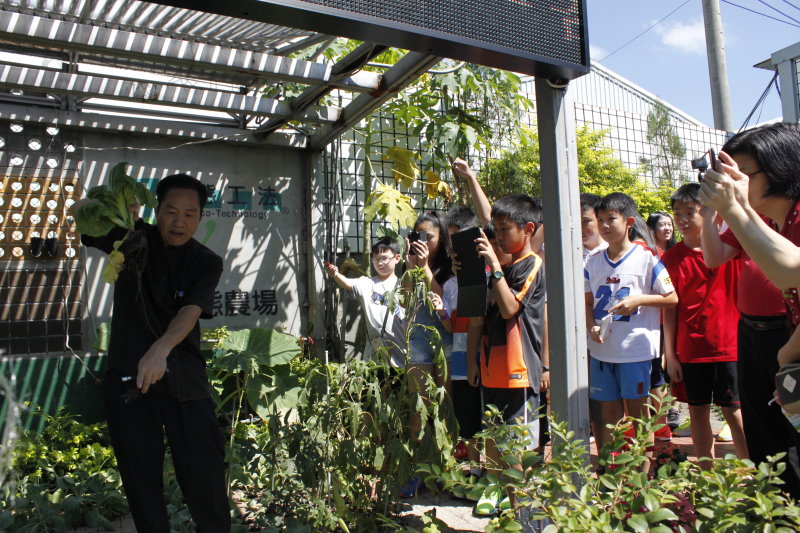

(26)Since you have a such amazing eco technology, have you think of promoting public construction?
In fact, more than ten years ago, once I have developed every bits of the technology, I thought about giving this patent to the government. Why did I want to give this invention to the government? It was because this invention was huge; it could impact the health of everyone, impact the whole human race, and impact the environment. This invention was even bigger than myself, so I didn’t want to be selfish. I thought about giving the invention to the government, so that they can use the power of the Ministry of Foreign Affairs to spread this technology to the whole world. Therefore, all the places using this pavement had to pay Taiwan with two types of money. Do you know the two types of money I’m talking about?
The two types of money are royalty and carbon tax. Since the technology can capture carbon dioxide, we can tax it. Do you know how much carbon tax that Taiwan can earn? Several trillions! The concept of having several trillions is astonishing. For example, let’s say that the people in Taiwan gets 20 trillions, an average person can have over a million dollars. You see, the climate summits in the world are talking about the carbon trading. This is exactly what I’m talking about. Although I see it while no one else does, there’s nothing I can do to help.
When President Shui-bian Chen was in the office, I sent my invention to the government for the first time. I own the technology and paid for all the expenses. I tried to give it to the government and asked nothing in return. However, the Vice Premier at the time, I-jen Chiou, simply replied to me, “Thanks, much appreciated!” That was alright; I was glad it was only one line, simple and direct.
When President Ying-jeou Ma took the office, I sent in my invention for the second time. It came back with the same result.
In the end, I just thought maybe god gave me this challenge, so I went to China and promote my invention there four or five years ago because it was almost impossible to do that in Taiwan. Therefore, this was the biggest mistakes I made, trusting the government to promote and implement instead of me, so that I delayed the best time to start.